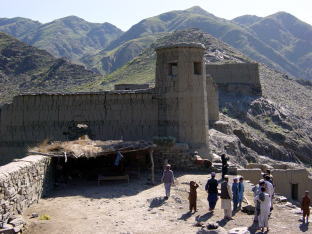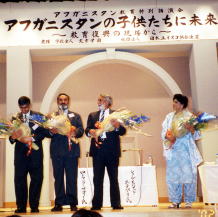Meguro UNESCO Short News No.188-2
The 49th General Assembly Report of Meguro UNESCO Association.
The 49th General Assembly of Meguro UNESCO Association was held on May
25, 2002 at Moriya Kyoiku Kaikan in Meguro from 1:30pm, attended by 55 members (with256 letters of attorney).
Ms.Hitomi Yokoo, a young member of Meguro UNESCO Association said an opening
speech.
Then all attendants prayed silently for the members who had passed away last year. Mr.Yakushiji,
the Mayor of Meguro City and Mr.Ohshio, the superintendent of Education of Meguro City offered their congratulations
and openedthe meeting. The bills belowwere discussed and approved in their original form.
Bills
1. Activity report / a statement of accounts / an inspection report in
2001.
2. Activity scheme discussion / a budget discussion / in 2002.
The bills were passed smoothly and Mr.Kizan Idaka, an adviser of Meguro UNESCO Association
gavethe closing address. Next, Mr.Yasuo Hirata, a vice-president,whorecently came back for a health check after 1 year in Nepal,reported
on the current state in Nepal.
At a later tea party, Mr.Eiji Hattori, an adviser of Meguro UNESCO Association gave
a toast to all people at the meeting and the meeting ended peacefully at
4:30 p.m.A mini-bazaar was held at the back of the hall and the amount soldwas 10,000 yen. Further, an activity committee for young people heldits first meetingof 2002.
Report on a Special Lecture
“Let Afghan Children have a Future”
Special lecture on Afghanistan, where education is being restored ~
Organizer: Bunkyo Gakuin, National Federation of UNESCO Associations in
Japan
Sponsor: Japanese National Commission for UNESCO, Asia/Pacific Cultural
Center for UNESCO
Date and Hour: June 6th, 2002 (Thurs) 18:30〜20:30
Venue: Jinai Hall, Bunkyo Gakuin University
A special lecture was given by the chairman and three members of the
Advisory Committee to the Education Minister, as mentioned on the previous
page. Ms. Shimada, Principal of Bunkyo Gakuin said in his opening address,
“Afghanistan is a juncture of Eastern and Western cultures and has developed
its own culture from ancient times.” He drew parallels with Japan's importation
of Buddhism among many other things. A video made by members of the National
Federation of UNESCO Associations in Japan showed the ruined city streets
and swarm of refugees spreading as far as the eye could see. The video
showed children smiling, studying in Terakoya initiated by the National
Federation of UNESCO Associations in Japan.
The MC introduced Ghulam Mohammad HAJIZADA, Chief of Education Planning
/ Statistics Bureau, who started his speech with the description of the
good old days in Afghanistan, followed by the tragic period that began
four years ago. He said that people under 24 years old were unable to get
an education, and that they knew nothing but war and weapons. He poured
out his heart saying he could do nothing for these young people, as though
he had been personally responsible for their plight. It was clear that
this man assumed a heavy responsibility to help restore the nation from
desolation.
The following is an excerpt from my memo:
We invited four senior staff from the Education Ministry in Afghanistan,
where peace is about to come at long last after enduring invasion from
foreign countries since 1979 and the long civil war before that. We held
“How Education Is Being Restored”
 War means tragedy and destruction. In Afghanistan, even children and young people carried weapons all the time during a war that continued as long as 25 years. Now that peace is returning, what is needed more than anything else is education. Now is the time to replace the weapons children have carried with pens and books. The nurturing of teachers should also be considered. Unfortunately, no facilities or materials for education are prepared. Some textbooks used 35 years ago will be re-used, though they are not complete. Under these circumstances, children hope to get an education. We feel responsible for the reconstruction of Afghanistan by giving a good education to our children.
War means tragedy and destruction. In Afghanistan, even children and young people carried weapons all the time during a war that continued as long as 25 years. Now that peace is returning, what is needed more than anything else is education. Now is the time to replace the weapons children have carried with pens and books. The nurturing of teachers should also be considered. Unfortunately, no facilities or materials for education are prepared. Some textbooks used 35 years ago will be re-used, though they are not complete. Under these circumstances, children hope to get an education. We feel responsible for the reconstruction of Afghanistan by giving a good education to our children.
The picture shows a planned construction site for Terakoya in Kunar Province. Some materials from the ruined building will be used.
“A Once Beautiful City, Kabul”
 “Did Your Husband like the Idea of Your Traveling to Japan?”
“Did Your Husband like the Idea of Your Traveling to Japan?”
the meeting described above. The hall with a seating capacity of 800 was
filled with people including Bunkyo Gakuin University students. First a
video was shown to introduce the children, the city streets, etc. followed
by speeches by each guest from Afghanistan. The following are a summary
of the speeches made through an interpreter, Mr. Farouq Asefi (from the Japan / Afghanistan Friendship Association)
“How Education Is Being Restored”
Mr.Lutfullah SAFI (Chairman of the Advisory Committee to the Education
Minister, an education consultant at UNESCO Kabul Office and former professor
at the Education Department, Kabul University.) Seen at the far left
in the picture.
The picture shows a planned construction site for Terakoya in Kunar Province. Some materials from the ruined building will be used.
“A Once Beautiful City, Kabul”
Mr. Ghulam Mohammad HAJIZADA(Chief of Education Planning / Statistics
Bureau.)
Second from the right in the picture.
Afghanistan is located at the heart of Central Asia. It is 1.7 times larger than Japan with a population of about 26 million. In old times, it was an agricultural country with verdant fields. It is a multiethnic nation but was well regulated. In the kingship era, education was not given universally but restricted to city dwellers until 1973, when the country turned into a republic. Since then education spread, improving the literacy rate and the country was on the path to modernization. Then war broke out which devastated all the cities. Now, nothing is retained that is reminiscent of the old days.
Second from the right in the picture.
Afghanistan is located at the heart of Central Asia. It is 1.7 times larger than Japan with a population of about 26 million. In old times, it was an agricultural country with verdant fields. It is a multiethnic nation but was well regulated. In the kingship era, education was not given universally but restricted to city dwellers until 1973, when the country turned into a republic. Since then education spread, improving the literacy rate and the country was on the path to modernization. Then war broke out which devastated all the cities. Now, nothing is retained that is reminiscent of the old days.
“What I Feel After Seeing Japanese School Education”
Mr. Sher Mohammad ETEBARI(Head of International Relations Bureau, Education
Ministry.) Second from the left in the picture.
Using computers in class, wonderful food services, the dexterity with which they use chopsticks to eat instead of fingers, well prepared school facilities, etc are very different to life in Afghanistan. People in Afghanistan had nothing to learn from the long war. Even making allowances for the different climate and customs between Japan and Afghanistan, I realized after I came to Japan that although man is born equal, peace in a country depends on whether the people are well-educated or not.
Using computers in class, wonderful food services, the dexterity with which they use chopsticks to eat instead of fingers, well prepared school facilities, etc are very different to life in Afghanistan. People in Afghanistan had nothing to learn from the long war. Even making allowances for the different climate and customs between Japan and Afghanistan, I realized after I came to Japan that although man is born equal, peace in a country depends on whether the people are well-educated or not.
Ms. Fahima HADI(Principal at Maryam High School in Kabul, a member of
the Advisory Committee to the Education Minister.) At the far right in
both the picture.
To tell the truth, my husband was not happy about my coming to Japan
this time. Last March, just before my visit to Japan, he also objected
to the invitation from the US. So I felt I should give in and not travel
here. People around me were surprised at this and said, “How come you
don't have a right to decide what you do after being engaged in education
for 27 years!” Although my family are dear to me, I began to put up a
fight when my colleagues and friends said I shouldn't give in. I talked
with my husband and other family members many times to win their approval.
I asked my brothers for cooperation and contrived various ways until at
last my husband agreed to my coming to Japan. It is regrettable that the
right for women to get educated was usurped during the repressive black
days when the Taliban ruled the country.